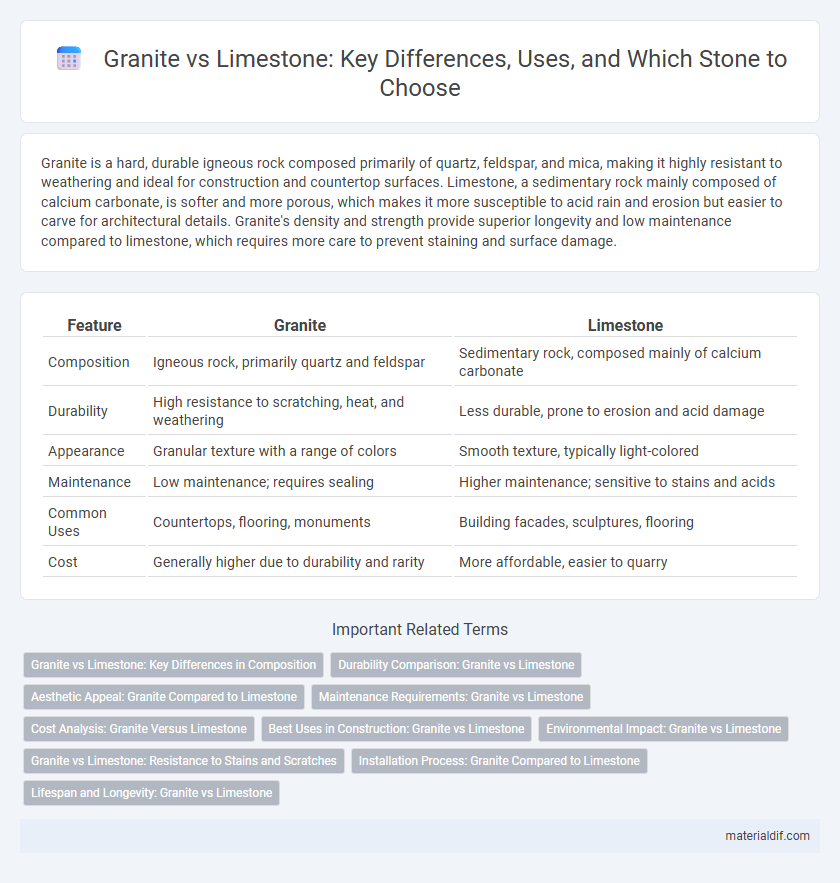Granite is a hard, durable igneous rock composed primarily of quartz, feldspar, and mica, making it highly resistant to weathering and ideal for construction and countertop surfaces. Limestone, a sedimentary rock mainly composed of calcium carbonate, is softer and more porous, which makes it more susceptible to acid rain and erosion but easier to carve for architectural details. Granite's density and strength provide superior longevity and low maintenance compared to limestone, which requires more care to prevent staining and surface damage.
Table of Comparison
| Feature | Granite | Limestone |
|---|---|---|
| Composition | Igneous rock, primarily quartz and feldspar | Sedimentary rock, composed mainly of calcium carbonate |
| Durability | High resistance to scratching, heat, and weathering | Less durable, prone to erosion and acid damage |
| Appearance | Granular texture with a range of colors | Smooth texture, typically light-colored |
| Maintenance | Low maintenance; requires sealing | Higher maintenance; sensitive to stains and acids |
| Common Uses | Countertops, flooring, monuments | Building facades, sculptures, flooring |
| Cost | Generally higher due to durability and rarity | More affordable, easier to quarry |
Granite vs Limestone: Key Differences in Composition
Granite is an igneous rock mainly composed of quartz, feldspar, and mica, giving it a coarse-grained texture and high durability. Limestone, a sedimentary rock, primarily consists of calcite and aragonite, forming from accumulated marine organic debris and characterized by a softer, porous surface. The key compositional difference impacts their applications, with granite's hardness suited for high-traffic surfaces, while limestone's calcium carbonate content makes it more prone to weathering and acid damage.
Durability Comparison: Granite vs Limestone
Granite exhibits superior durability compared to limestone due to its igneous origin, featuring a dense crystalline structure that resists scratching, heat, and weathering. Limestone, a sedimentary rock, tends to be softer and more porous, making it susceptible to erosion, acid rain damage, and surface wear over time. For high-traffic or outdoor applications, granite offers enhanced longevity and strength, while limestone may require more maintenance and protection.
Aesthetic Appeal: Granite Compared to Limestone
Granite exhibits a striking, granular texture with a wide range of colors and patterns, making it highly sought after for its luxurious and vibrant aesthetic appeal. Limestone offers a softer, more muted appearance with subtle earthy tones and a matte finish, providing a classic and understated elegance. The reflective, polished surface of granite creates a dynamic visual impact, while limestone's porous nature contributes to a naturally weathered, rustic charm.
Maintenance Requirements: Granite vs Limestone
Granite requires minimal maintenance due to its dense, non-porous surface that resists staining and scratching, making it ideal for high-traffic areas. Limestone, being more porous and softer, demands regular sealing and careful cleaning to prevent damage from acids, stains, and wear. Proper maintenance schedules significantly impact the longevity and appearance of both materials, with granite offering a more durable, low-upkeep option compared to limestone.
Cost Analysis: Granite Versus Limestone
Granite generally costs more than limestone due to its durability and density, with prices ranging from $40 to $100 per square foot compared to limestone's $30 to $70 per square foot. Installation and maintenance expenses are also higher for granite because of its hardness, which requires specialized tools and labor. Limestone, being softer and easier to work with, often results in lower overall project costs but may incur more frequent upkeep expenses over time.
Best Uses in Construction: Granite vs Limestone
Granite's durability and resistance to weathering make it ideal for exterior applications such as countertops, flooring, and monuments, while limestone is favored for interior walls and decorative elements due to its softer texture and ease of carving. Granite's high compressive strength supports heavy structural uses like bridges and building facades, whereas limestone's porosity limits its use in high-moisture environments but enhances its thermal insulation properties. Both stones offer unique aesthetic qualities, with granite's granular texture and variety of colors contrasting limestone's uniform, pale appearance suitable for classical architectural styles.
Environmental Impact: Granite vs Limestone
Granite extraction involves significant energy consumption and habitat disruption but offers superior durability, reducing the need for frequent replacement and minimizing long-term environmental impact. Limestone quarrying emits less carbon dioxide during processing but is more susceptible to weathering, potentially requiring more frequent maintenance and increasing resource use over time. Choosing between granite and limestone depends on balancing initial environmental costs with lifespan and maintenance requirements.
Granite vs Limestone: Resistance to Stains and Scratches
Granite exhibits superior resistance to stains and scratches compared to limestone due to its dense, non-porous composition and high hardness rating on the Mohs scale. Limestone, being a softer and more porous sedimentary rock, is more susceptible to etching, staining, and surface damage from acidic substances and abrasive materials. This makes granite a preferred choice for high-traffic kitchen countertops and outdoor applications where durability is critical.
Installation Process: Granite Compared to Limestone
Granite installation requires specialized tools and techniques due to its hardness and density, demanding professional cutting with diamond blades and precise anchoring to support its weight. Limestone, being softer and more porous, allows for easier cutting and handling but needs careful sealing to prevent moisture penetration. The durability of granite makes its installation more labor-intensive and costly, while limestone offers more flexibility but requires ongoing maintenance after installation.
Lifespan and Longevity: Granite vs Limestone
Granite is significantly more durable than limestone, offering a lifespan of 50 to 100 years or more with proper maintenance, while limestone typically lasts around 20 to 40 years under similar conditions. The superior hardness and resistance to weathering of granite make it ideal for high-traffic areas and exterior applications where longevity is critical. Limestone's softer composition makes it more prone to erosion and wear, reducing its effective lifespan compared to granite.
Granite vs Limestone Infographic

 materialdif.com
materialdif.com